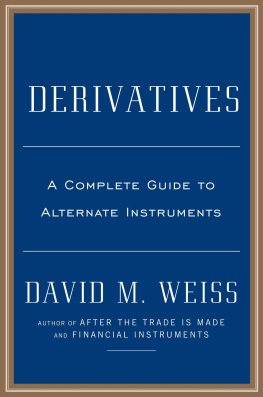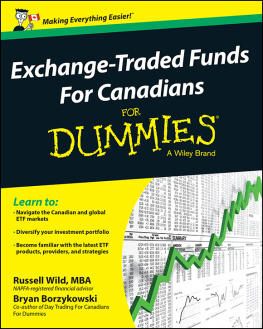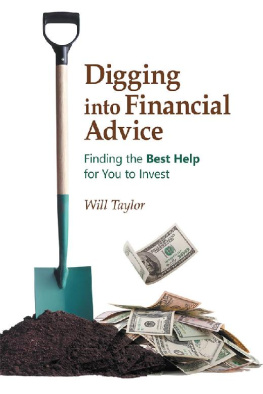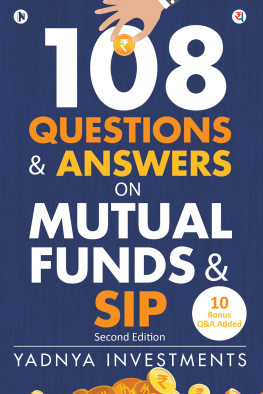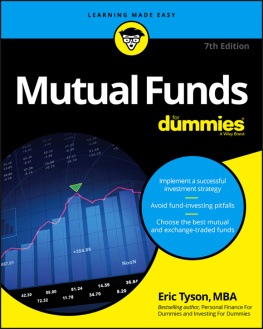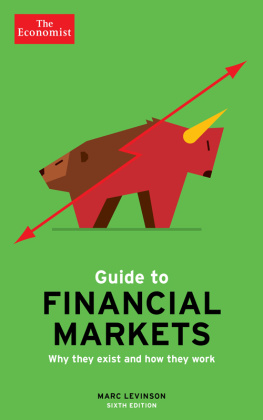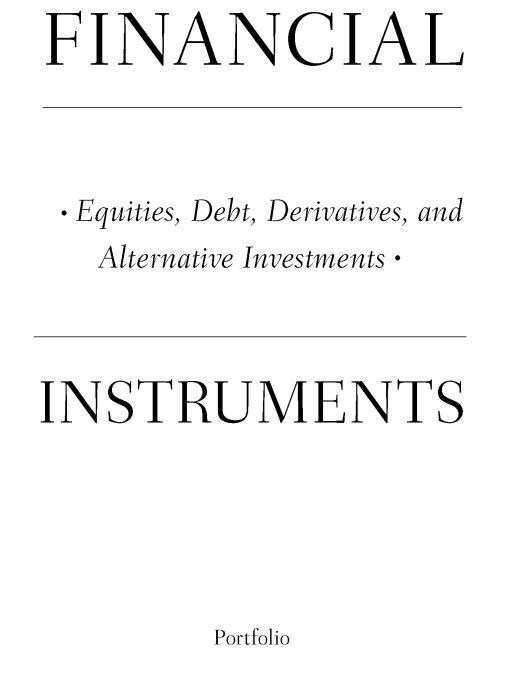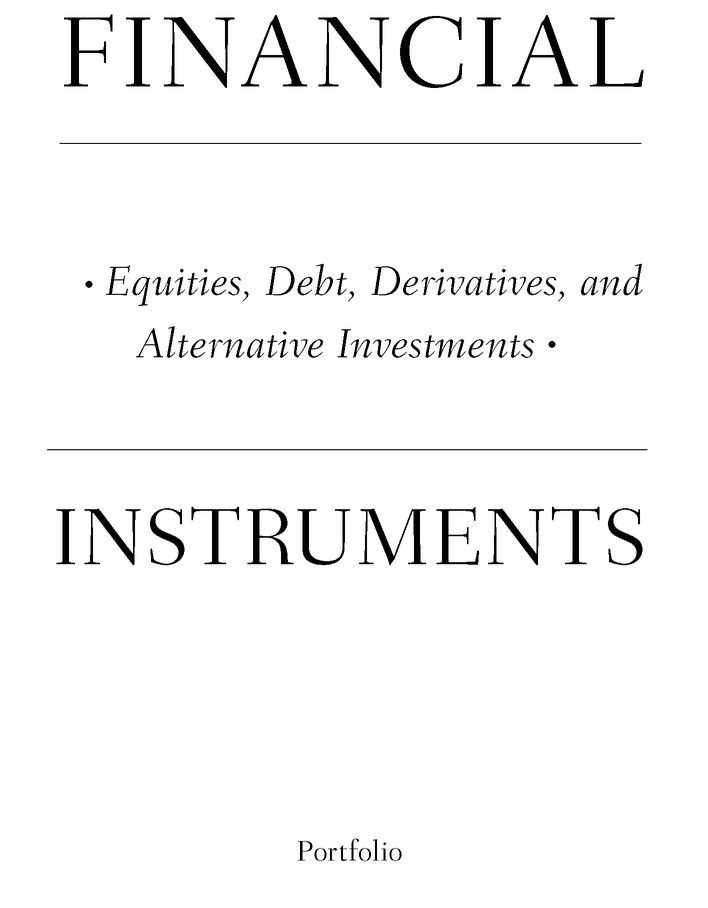Table of Contents
DAVID M. WEISS
TO MY FAMILY
To: Marcia, Randi, Craig, Nicole, Jenna, and Carly.
Thank you for your support, patience, and understanding.
TO MY COLLEAGUES
To my colleagues both past and present: Some of us have
traveled a long road together; others are fairly new
acquaintances, yet it has been my honor to know and, in
many cases, to have worked with you. Some have educated
me and some of you I have educated. I thank you for your
friendship and adding to an interesting career.
It is my hope that you find this book informative
and worthy of your time.
Introduction
Products, products, products! Each day there seem to be new financial products being offered into the market or older ones gaining new features. Some are direct obligations of the issuer, others are derivatives, and still others are derivatives on derivatives. We trade instruments that range from bonds that have a direct claim against the issuer to options whose underlying products are futures, whose underlying products are indexes, which are three derivatives, the base of which does not have any direct value. We trade collateralized debt obligations that are composed of various types of loans and mortgages, which have been pooled and securitized and shares issued against the basket of debt without the ability to determine which loans are against which shares. With this onslaught of products comes new terminology and strategies, followed by books, periodicals, and other media sources dedicated to the particular product, and the proliferation continues.
This book was written to provide a base from which the reader can gain a foundation for the major products traded. Each productwhat it is and how it functions in the marketplaceis explained in a straightforward manner. Due to the books wide panoramas of products it is general in nature, keeping the more in-depth mathematics, analytics, and complex strategies to the more productcentric documentation.
With the constant march forward of technology, we are able to execute large block trades in less time than it took to enter an order a few years ago. We can make an indexes portfolio into deliverable product and trade against the actual basket of stock, and we can still buy one share of stock. We have come a long way from marking quotes on chalkboards or looking up prices on the pink sheets, and fifty years from now someone will communicate a financial dissertation into an education tablet that can be taken with a beverage, and it will reference today as the old days.
This book takes the reader from equities and debt instruments to derivatives and structured products. It concludes in the working of the markets and the different forms of margin; all parts are aimed at what it is and how it works.
I hope it is of value to you.
EQUITIES
Common Stock
INTRODUCTION
Known as ordinary shares in other parts of the world, common stock is probably the best known of all the financial products. To most people it is the ticket to wealth. They come to make a killing in the market, yet in the long term, many of them are no longer with us and the market is still here. So who killed whom? Bernard Baruch has been credited with the following two statements;
Nobody ever lost money taking a profit.
The main purpose of the stock market is to make fools of as many men as possible.
The common-stock market spans the length and breadth of the financial spectrum, from a new start-up company to a mature conglomerate, from a mom and pop shop to an international giant, from a domestic corporation to a foreign company. All want to do the same thingget the public to invest in them. This is a way for a company to raise capital. It is literally selling shares of itself to the public.
CORPORATE FORMATION
The issuance of its shares and its capitalization structure, as well as what a corporation may or may not do in the carrying out of its business model, is covered by the corporations charter and bylaws. The charter and bylaws also spell out the rights of its shareholders. Who is empowered to act on behalf of the corporation and in what capacity is detailed in the corporate resolution. These three documents are the basis under which the corporation will exist.
Most common-stock issues come to market through a formal underwriting. The company and its investment managers negotiate the terms of the underwriting. The reason for the underwriting is for the company to raise capital (cash). A key question is why it needs cash; is it to expand the company or to pay off debt or just to keep the company afloat? Each answer would take the investor down a different path. Another question, especially in the case of a new issue, is how much of the capital infusion is going to pay the company insiders for the private stock they received in lieu of cash compensation. There is nothing wrong with this practice, but the amount could be abusive.
When a young company starts up, one item that it is usually short of is cash; it therefore enters into agreements with lawyers, accountants, and anyone else who will accept shares of stock in lieu of cash. The understanding is that they will sell the stock (all, some, or an amount that is up to the recipient) at a later time when the company is established. The sale of the stock will bring in the cash the recipient was denied originally. This is a gamble on the part of the recipient. If the company fails before the recipient has a chance to convert those shares, he or she did all the work for nothing. On the other hand, the offering could be a huge success (known as a hot deal) and the recipients could convert their stock at a dollar amount far in excess of what they originally negotiated. The percentage of the new offering that will benefit these individuals, and much more information, can be found in the prospectus that is sent to the buyers of newly issued securities and can be requested by a potential buyer from an underwriter or the firm the individual has an account with. The prospectus is required under federal law as part of the Securities Act of 1933 (the 1933 Act). Unfortunately, most people do not read the prospectus, so it is possible for unscrupulous individuals to get away with some fictitious or misleading story about the issuer.
When a company seeks out an underwriter, it is looking for definable qualities and services. Likewise, when an underwriter takes on a client, it too is looking for definable qualities and characteristics. The adage birds of a feather flock together is very true in this relationship. A start-up company does not need all the services that a global underwriter can offer, and a small underwriter with limited contacts cannot properly service a large, privately held company issuing its stock to the public. However, as with anything else we do, there is the best of the small and the worst of the big. It is up to each to seek out the appropriate other.
A new company or a small company going public can raise up to $5,000,000 without a formal underwriting. It is known as a Reg. A offering. Regulation A of the 1933 Act exempts some issues from formal registration. If an issue is for not more than $5,000,000, including no more than $1,500,00 being sold by insiders, it may qualify under this regulation. It cannot be made in addition to a prior offering or sale of the companys security. Form 1-A notice must be filed with the Securities and Exchange Commission (SEC) and qualified by the SEC. The form must state:


